Final report for ONE21-387
Project Information
The objective of this research was to evaluate the effectiveness of the materials when applied with stacked bedding management to improve conditions for bird growth and health. Stacked litter management has been observed to provide the greatest benefit from the bedding materials by frequently applying thin layers of fresh absorbent bedding over the surface of tightly caked litter surfaces. That allows for drying and absorbing the new excreta and for ammonia reduction and absorption. This also improves foot pad, leg, and breast health.
In this study we combined investigations of some trial bedding materials with the use of the stacked litter method to find ways of improving bird performance and health. In comparing these newer materials with a standard control of sawdust we learn more about ways to improve bird health.
The project was conducted in a turkey production facility in central Pennsylvania. A brooder pen was divided into four equal quadrants with the four test bedding materials used in each quadrant. The fore materials included a control of sawdust and three more advanced bedding materials produced by PittMoss LLC from Ambridge Pennsylvania. Throughout the study the three materials are designated as A-PM, B-PM, and C-PM. All three materials are covered by a patent and are different renditions of absorbent materials manufactured from clean recycled industrial cardboard and paper waste. The cardboard and paper stock are fiberized and reformatted into particles engineered to optimize porosity and absorption for applications to poultry bedding. Much was learned in applying the new more sustainable bedding materials in the stacked liter management system. These examinations and evaluation of factors that influence bird health have application to everyone who raises poultry. In this project we thoroughly tested the physical and chemical impacts of three new sustainable recycled materials. Our efforts were applied to evaluate whether the new bedding materials were superior to the most commonly used materials. The comparisons of three new innovative versions of bedding from PittMoss LLC to sawdust demonstrated an improved effectiveness of the trial materials. The new materials were shown to absorb ammonium 75% better and maintain a lower pH and higher air holding ability thus reducing the ammonia emissions. The properties of the materials presented showed up to 75% reductions in ammonia gas emissions into the ambient air over the bedding. Additional evaluations of the nitrogen content and conversions showed that the experimental bedding absorbed and sequestered the nitrogen more effectively in thus reduced the opportunity for leaching and runoff from the manure. Another good result is the reduction in moisture content and provide better absorption of the excreta. The data shows that the experimental materials work as good as or better than the sawdust control. As a further benefit the surface drying of the experimental materials was consistently better than that measure for the sawdust. The particle structure in the experimental bedding provided for lower surface moisture thus significantly contributing to better bird health.
The well-being of the birds was observed to be very good. Observations by the farmer indicated that the poults spent equal time over all the bedding materials and the accumulation rate of excreta appeared to be the same overall materials. It is clear that with the decreased moisture levels in the bedding and the improved chemistry many of the health problems associated with the poor-quality bedding will be greatly reduced when using the more sustainable formulations developed by PittMoss LLC. In this project triple benefits are observed. We have found ways to improve the bird health, reduce the probability of pollution from manure, and use material destined for the landfill for a beneficial purpose.
This project seeks to advance poultry production using a sustainable and more environmentally compatible bedding material. We will compare the newly manufactured lignocellulosic materials verse sawdust bedding and with the properties that promote bird health and wellbeing.
The project will:
- Compare the new bedding materials to sawdust for effectiveness when used in a stacked bedding system to:
- Absorb and hold ammonium,
- Avoid conversion of ammonium to gaseous ammonia,
- Absorb moisture from excreta,
- Improve moisture release properties,
- Maintain lower surface moisture,
- Hold nitrogenous compounds in manure storage.
- Observe bird acceptance by observing time and behavior on the compared bedding materials and comparing the accumulation of manure and caking.
The information collected in the trial of the new bedding materials and the use method of “Undisturbed Layered Stacked Litter” could encourage a new management style that is a more sustainable, environmentally conscious, and energy efficient method for litter management. The project would serve as a demonstration of the benefits the manufactured bedding provides which lead to increased bird health and profitability. The developed information will have application to the smallest back-yard grower to large commercial operations. It will stimulate further innovations for more environmentally sustainable production.
Bird health, growth, wellbeing, and profitability are dependent on good litter management systems. Small and large farmers are facing social pressures for odor control, governmental regulations, and environmental concerns. In the Chesapeake Bay nutrient pollution of ground water is highly attributed to the poultry industry (Rogers, 2017). Efforts are needed to more aggressively develop materials, methods, and management systems to more sustainably produce poultry with increased environmental stewardship.
Growers, poultry enthusiasts, and researchers have said that “As the litter goes, so goes the flock!” (Barkley 2017). The quality and effectiveness of bedding impacts; mortality, feed conversion, growth rate, disease pressure, foot pad health and breast quality, and overall bird health. Farmers are most concerned with controlling ammonia emissions, surface moisture, and labor required in managing the bedding.
Ammonia emissions must be maintained below 25 ppm for bird health, which is about the level detectable by the human nose. Control with alternative bedding during the early weeks of production has commonly been effective (Barkley, 2017). However, as bedding cakes over with feces emission levels increase, and control of ammonia and moisture become much more difficult. Many growers apply additional chemical additives to help reduce the emissions.
Litter surface moisture reduction is a primary goal to limit disease, improve bird health, and reduce foot pad dermatitis (Shepard 2017). Good ventilation is essential. Considerable heating is required for production, however, ventilation fans exhaust the moisture and ammonia, wasting energy and polluting the atmosphere.
This project proposes a solution to reduce in house environmental gaseous ammonia pollution and decrease litter moisture to create an environment to improve bird health and growth.
An invention by PittMoss LLC for producing sustainable potting soils from recycled waste cellulosic materials applies here. The processed cellulosic material is composed of exposed activated fibers with a remarkably high ability to absorb moisture and ammonium. Seeing that, some PittMoss LLC employees felt that it was logical that the material would also have value in absorbing ammonium as an animal bedding. The material has a physical structure that increases internal porosity and provides better fluid absorption and translocations. An employee with a backyard chicken house tried the material and thought it was fantastic. The formulation was then tried in an organic commercial broiler operation where it significantly reduced gaseous ammonia levels and reduced mortality, gave cleaner foot pads, increased feed conversion, and produced larger birds. Then a larger commercial farm compared the new material to wood shavings and the results were excellent. While these trials were very promising the current cost is too high for using it at about 3 to 4 inches. Since it appears that the absorptivity and drying properties are quickly blocked by the caking over with feces it was assessed that a change to repeated thin applications in an “Undisturbed Layered Stacked Litter” management system may be very effective in reducing ammonia and drying the litter. Therefore, this system must be tried and demonstrated in a carefully monitored system to improve bird health and environmental quality more sustainably.
Cooperators
- - Technical Advisor (Researcher)
- - Producer
Research
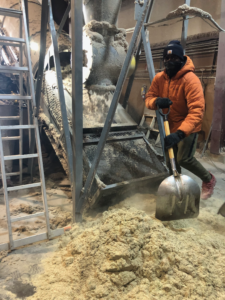
Methods as proposed
Key to this trial is a comparison of the effectiveness with property changes of four bedding materials when used in an “Undisturbed Layered Stacked Litter” management system. The focus is on quantifying and monitoring properties that are known to influence health, growth, and impacts on the environment.
Four bedding formulations will be trialed. Sawdust is the control and has typically been used by the farmer. Three other new and unique cellulosic materials will be trialed. All are substrates engineered and manufactured by PittMoss. They are composed of recycled cardboard, newspaper, and natural farm raised fibers. Some of them contain approved organic natural mineral additives that can influence the abilities to absorb and retain ammonium, absorb liquids, and influence moisture management. All are designed to provide a high degree of exposure to fiber surfaces while having high internal porosity for absorption while allowing increased gas exchange. The high rate of hydraulic conductivity provides easy surface drying and moisture movement. These formulations are proprietary and will be identified as “A”, “B”, and “C”. Bedding “A” is a basic lignocellulosic blend and has already been proven effective and advantageous in broiler production. Bedding “B” is like “A” but modified with minerals to remain more acidic and further avoid release of gaseous ammonia. Bedding “C” is further structurally modified using locally raised biomass to further increase the physical structure and resilience against compaction. While these properties are present at installation the changes under the rigors of growth are expected to alter the properties and effectiveness. Monitoring these changes over the growing period in “Undisturbed Layered Stacked Litter” management systems is expected to show exceptional values for poultry production.
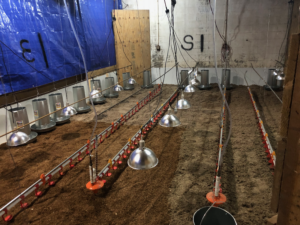
For comparisons in production the trialing pen (25’x25’) will be partitioned into 4 sections across the watering and feeding systems so that uniformity exist in all the sectors. All heating, feeding, and watering will be uniform and efforts to maintain uniform ventilation will be made. Circulating fans will be used to equalize temperature and air movement. To begin a 3” layer of each bedding will be put down on each quadrant of the clean floor. After two days 1000 turkey poults will be introduced into the pen with the four communal sectors.
Birds will be carefully observed by Mr. Jones during the first two weeks and the differences in apparent comfort and dwell time on the different substrates will be noted. After 2 weeks the first of a series of observations, measurements and litter sample collections (designated as “LSC”) will commence. The on-site data will include ambient ammonia levels (with 10 replicates at 12 inches above each bedding type), bird observations including dwell time and apparent comfort on each litter type, and litter caking will be rated. Sampling for off-site analyses will include sample collection (from full depth of the bedding) with 3 representative samples from each of the 4 bedding types which are then each combined into one composite sample per bedding type for lab testing. All from representative areas (avoiding waterers, feeders, and edges), which will make 4 composite samples for each LSC. Ammonia measurements will be taken with a Forensic Detectors portable ammonia meter. The surface caking on the litter will be scored as to the
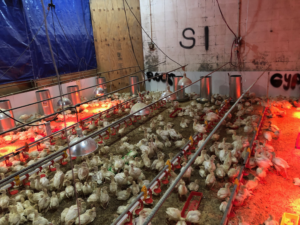
degree of caking according to the system described by Amy Barkley (2017). A repeated LSC will be taken two weeks later just before the first batch of poults are moved. After the sampling and removal of the poults the area will be prepared for the second batch. Any holes and mounds will be roughly leveled and a new layer of only 1” of fresh bedding of each formulation (sawdust, A, B, & C), will be applied on top of the respective existing litter types. After at least one day a second batch of poults will be populated into the emptied and redressed pen. Then at two weeks and four weeks another series of LSC will take place. This cycle will also happen for the third, fourth and fifth batch of poults. Additionally, the last set of poults will remain in the original brooder pen to grow out and finish the season. During the grow-out a series of three monthly top-up applications of 1” of the respective litter types will be spread onto the respective trial sections to finish the grow out. In the grow out monthly LSC will be taken. From this sequential sampling the physical and chemical testing will be used to profile effect on bird health and environmental impact.
THE MEASUREMENTS WILL INCLUDE:
Ambient Ammonium Levels: (spot measurement with Forensic Detectors portable gas meter.) performed on sight.
pH: North Carolina State University Substrates Lab Std. Method (NCSU-SUB-METH) performed at PittMoss Q/C Lab on each sample.
Nitrogen Balance (Total N, Ammoniacal N, Urea, Nitrate, and Nitrite): (performed by MMI Lab using USDA Methods), four sample composites of the virgin bedding materials, bedding after first two weeks, and again at the end of the season will be performed.
Total Nutrient Analysis: (performed by MMI Labs USDA Methods) four sample composites of the virgin bedding materials, bedding after first two weeks, and again at the end of the season will be performed.
Total Soluble Salts (Electrical conductivity): (NCSU-SUB-METH) performed at PittMoss Q/C Lab on each sample.
Wet (as is) and Dry Bulk Density: (NCSU-SUB-METH) performed at PittMoss Q/C Lab using on each sample.
Moisture (as is) on Dry Weight and Volume Basis: (NCSU-SUB-METH) performed at PittMoss Q/C Lab on each sample.
Moisture Holding Capacity on Weight and Volume Basis: (NCSU-SUB-METH) performed at PittMoss Q/C Lab on each sample.
Hydraulic Conductivity: (NCSU-SUB-METH) performed by NCSU Substrates Lab three sample composites performed at the end of each flock of poults and monthly in final grow out.
Space Distribution for Air, Water, and Solids: (NCSU-SUB-METH) performed at PittMoss Q/C Lab using on each sample.
Moisture Release Curves: (NCSU-SUB-POROMETER METH) performed by NCSU Substrates Lab four sample composites performed at the end of each flock of poults and monthly in final grow out.
Water Activity Levels: (Method used by Amy Barkley) using four sample composites performed at the end of each flock of poults and monthly in final grow out.
Relative Drying Rate: Three replicates of the virgin bedding samples and control, using self-designed table top in tray methods based on a method by Amy Barkley).
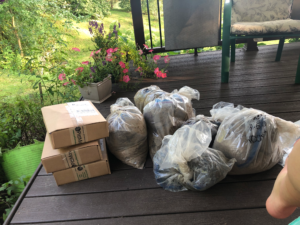
Data from each parameter measured and displayed chronologically to demonstrate the influence of the litter stacking over time. The parameters will be correlated to the gaseous ammonia, nitrogen levels, bird acceptance, litter caking and among the other measured properties. Statistical analyses including mean separation (Tukey’s) will be applied to define significant differences in the treatments over time and reported where appropriate. Through multiple linear regression analysis, relationships will be developed to demonstrate shifts in properties over time. Graphics representations of key findings will be developed to display the factors that had the highest correlations to measured parameters of the litter. Finally, the differences in the four bedding materials will be rated and displayed in charts and tables for presentation. Findings will be reported in a series of interim reports, culminating in a final report.
January 2022 Report:
We have measured the moisture absorbing properties of the bedding materials to be used and find that the Ag fiber, paper, and cardboard based materials have very high moisture holding compared to saw dust. Also, the dry and moist bulk densities vary considerably and a baseline for these properties is being established. A late March beginning of the pen trials is planned.
January 2023 report:
The bedding material trials with this crop of turkeys has been completed. There were six cohorts of poults totaling over 5,500 turkeys spread over the months of April to July. Densities were often times very high depending on the schedule of incoming poults, rapidly growing adolescents and final processed birds. Bedding was applied at the farmer's discretion and in four major events between poult cohorts while pen 1 was empty. The depth of bedding grew from 3" in early April to 30-36" in total depth by October. The farmer ran out of trial bedding in late July, perhaps due to over application, and finished the season with topdressings of sawdust as needed. Adjacent pens (2 &3) were added to data collection events to provide a comprehensive look at the farmer's usual operations of layering with sawdust. Data and samples were collected from six sampling events of the project area and over ten visits to the farm. All sampling events have associated lab work that is still being analyzed. Many laboratory tests have been completed. Four of the fourteen categories of measurements remain to be finished. An update of some of the findings is presented here.
December 2023 Final Report
After extensive farm and lab work and following some health interruptions the project has finally been completed. The repost has many sections that build to a final summary of findings.
INTRODUCTION:
The objective of this research is to evaluate the effectiveness of the materials when applied with stacked bedding management to improve conditions for bird growth and health. Stacked litter management has been observed to provide the greatest benefit from the bedding materials by frequently applying thin layers of fresh absorbent bedding over the surface of tightly caked litter surfaces. That allows for drying and absorbing the new excreta and for ammonia reduction and absorption. This also improves foot pad, leg, and breast health.
In this study we combine investigations of some trial bedding materials with the use of the stacked litter method to find ways of improving bird performance and health. In comparing these newer materials with a standard control of sawdust we learn more about ways to improve bird health.
The project was conducted in a turkey production facility in central Pennsylvania. A brooder pen was divided into four equal quadrants with the four test bedding materials used in each quadrant. The fore materials included a control of sawdust and three more advanced bedding materials produced by PittMoss LLC from Ambridge Pennsylvania. Throughout the study the three materials are designated as A-PM, B-PM, and C-PM. All three materials are covered by a patent and are different renditions of absorbent materials manufactured from clean recycled industrial cardboard and paper waste. The cardboard and paper stock are fiberized and reformatted into particles engineered to optimize porosity and absorption for applications to poultry bedding.
IMPORTANCE OF PHYSICAL PROPERTIES:
Poultry bedding materials are used to promote health and cleanliness. The physical properties of the bedding must produce high absorbance and remain as dry as possible while protecting the birds from the effects of their own excreta. The density needs to be sufficient to stay in place and provide a structure that is not damaging to the bird’s feet and breast. Material must have the ability to absorb and hold moisture to maintain dryness providing for disease reduction. Good physical properties impact the chemistry of the litter and helped to reduce ammonium emissions and avoid low oxygen conditions that can lead to increased disease development. Particle density, size, and form influence the ability to absorb excreta and hold moisture while still drying from the surface.
BULK DENSITY (WEIGHT/CUBIC FOOT):
The density of a material used for bedding must be light enough for easily handling, shipping, and application. It must be heavy enough when dry to stay in place with the movement of birds and air. The particle that makes up the mass cannot be too dense and must readily absorb fluids and help to dry the feces. The accompanying figure ‘Average Bulk Density by Bedding Type” presents the density (weight per cubic foot) of the four trialed materials. It also presents the wet sampled and oven dried densities as averaged over the five samplings. The samples were taken after each set of brood poults were removed and extracted from three locations in each of the trial sectors and down to the full depth of the litter (new and old).
Average Bulk Density Bedding Type
In the graphic we see that the sawdust Base Bedding material was considerably heavier than the three experimental blends. After being successively spread in layers over the surface of the “floor” then trampled and absorbing deposits of excreta the dry density becomes much higher and more uniform between bedding types. This uniformity in dry weights after cropping indicates that the three research blends absorbed proportionately more excreta than the sawdust. Additionally, the lower wet bulk density in the research materials indicates that the research materials are tending to dry more readily during cropping. From these observations it is clear that the research bedding materials work very favorably in the stacked bedding system
MOISTURE ABSORPTION AND DRYING:
The moisture absorbing and holding ability is the most significant part of this study. Absorption of fluids is critical to maintaining good bird health. Some bird houses do not have sufficient ventilation and the humidity and ammonium levels can become so high that damage occurs in the birds, reducing feed conversion and growth rates as well as creating long lasting health problems.
The ability of bedding materials to absorb fluids can be easily measured by comparing weights of dry and wet bedding. This is accomplished by soaking the bedding material and comparing wet and dry weights. The graphic on “Fluid Absorption Ability” presents the relative percent by weight and by volume of five different common bedding materials. The figure shows that sawdust and shavings have the lowest moisture holding ability while straw is higher but approximately the same as peat and the PittMoss base product used for the experimental blends (PM-Roost) had the highest absorption based on both weight and volume.
A graphic presentation of the comparisons of the bedding types in “Stacked Litter Moisture Content Over Successive Broods” from this research project is linked here. It shows the moisture levels on a weight basis beginning on May 4th at the end of the first brood through to August 5th at the end of the fifth brood. It charts the moisture levels for each of the research materials and as the stacked bedding accumulated. Across the board the sawdust moisture level was the highest from the beginning until the end. Keep in mind that the moisture levels are a reading from the fully stacked top to bottom sampling. They all maintain the same general pattern but the three PittMoss research blends did not rise to the high moisture level of the sawdust blend at any time. The moisture increased the most during the first and fifth broods. These three middle samplings on May 18th, June 3rd, and on June 29th were lower. In this observation it is proposed that the lower mid-term moisture is
Stacked Litter Moisture Content Over Sucesive Broods
due to the more effective surface drying during those warmer times and the PittMoss blends with the good hydraulic conductivity draw moisture from the lower levels of the stacked litter more effectively. In all we clearly see that for stack litter management the treatments including the three PittMoss blends yielded a much lower over-all moisture than the sawdust bedding.
RELATIVE DRYING RATES:
Significant differences were observed in the relative drying rate of the trial bedding materials. This was demonstrated in an experiment that compared evaporation of the water from the surface of each fully saturated bedding material. In the experiment we placed triplicate replications with one liter of fully saturated bedding layered one inch thick on plates that sat in ambient air for 10 days. The results are displayed in the graphic “Surface Drying Rates of Trial Bedding” In it we can see that the sawdust evaporation amount over the ten days was about 58% of the PM-A & PM-B formulations and 64% of the evaporation amount for the PM-C formulation. All three of the PittMoss formulations had a significantly higher water evaporation than the sawdust. The physical structure and the engineered particles in the PittMoss trial blends are believed to contribute to better drying.
Surface Drying Rates of Trial Bedding
PHYSICAL PROPERTIES & CHANGES FROM CROPPING:
The physical space distribution in the bedding materials influences the ability to absorb the bird excreta while maintaining good properties for holding urine and feces. As the birds age and grow the pressures on the bedding (litter) become greater. Typically, the bedding material is most effective when first applied but in two to three weeks the bedding can become caked-over with feces and has little effect on absorption of added moisture and feces. That then increases the possibilities of high surface moisture and toxic ammonia emissions. This then presents the main argument for the stacked litter management system. Regular and repeated applications of a thin layer (1 to 2 inches) provide for ready absorption of newly deposited excreta. The absorptivity of the bedding is a result of the physical properties of the bedding. Particle sizes and density influence the rate and quantity of absorption. Those particles create a physical environment for holding fluids while also allowing for sufficient air space thus allowing oxygen to penetrate the litter.
By defining the physical properties provided when the bedding is laid down, we can quantify the physical space distributions in the bedding materials. Testing the materials by saturating each with water, then draining each, we can determine the air space at saturation. This is accomplished by measuring the quantity of the water drained. Then by measuring the weight change in drying we can obtain the capacity of the material to hold fluids (from fully dry to fully saturated). Finally, the remaining weight represents the solids that take up space. The linked graphic “Physical Space Distribution” presents the measurements of the percentages of space that is occupied by solids, liquids, and air when fully saturated. This provides a measure of the theoretical capacity for holding gases and liquids.
In this graphic we see that in the fresh unused bedding materials the quantity of theoretical air space, which provides for gas exchange, is approximately identical for all three PittMoss research materials and the sawdust can provide greater air space. The space represented as solids is the percentage of space occupied in the bedding material that cannot absorb fluids or provide gas exchange. In comparing the solids present in each of the bedding types we see that sawdust has approximately 7% more of the space occupied by solids therefore it has 7% lower total absorptive capacity compared to the three PittMoss experimental versions. The percentage of space that can hold liquids, or be filled with excreta, ranges from approximately 15 to 17 percent higher in the PittMoss trial blends than in the sawdust.
ACCUMULATED SOLIDS:
As anticipated for the project the solids accumulated at approximately the same rate for all tested substrates in each sector of the communal trial room. The linked graphic “Increase in Space Occupied by Solids” charts the accumulation of solids. It shows that there is very little difference in the rate of accumulation for different bedding types.
Increase in Space Occupied by Solids
In representation it is apparent that over the sequence of five different settings of brooding poults, the solids increase averaged approximately 20% in each material. That further indicates that the young poults spent approximately equal residence time over each of the experimental quadrants. This increase in solids is due to increased feces deposits and compaction from bird traffic. Together they impact the ability to absorb additional solids and fluids while reducing air space.
CAPACITY TO HOLD FLUIDS:
The capacity to absorb moisture was measured over successive broods of poults. Those changes are depicted in the attached graphic showing the “Capacity to Hold Fluids”. Note that the potential fluid absorbing capacity appears to have substantially increased after the first set of poults (for reasons not explained) and then tended to remain the same with the added bedding layers through to the end of the fifth set of poults. Keep in mind that this represents the capacity for holding fluids if totally saturated and not the content of fluids in the sampled litter.
TRENDS IN AIR SPACE:
The accumulation of fluids and the increase in accumulation of solids reduced the airspace over the series of successive broods of poults. The linked graphic shows the “Trends in Airspace” for all four trial materials. The changes in solids within the composite of stacked litter appear to be approximately the same for all the materials The airspace was reduced in each at about the same rate consistent with the litter accumulation of more excreta. This reduction in air space also reduces the possibility of gas exchange, which is not necessarily a problem, to a point but can develop conditions that limit oxygen penetration into the litter and intern can increase ammonia gases.
CHEMICAL PROPERTIES & ANALYSES:
Total mineral analyses were performed on the initial bedding materials and litter produced from the stacked litter method after five cycles of brooding turkey poults. Both soluble mineral measurements, using the saturated media extract method (J.R. Peters Lab, Allentown PA), and total digested mineral content from compost analyses, (MMI Labs, Athens GA) were performed. Differences in water soluble (mobile) mineral levels and total content can be distinguished by comparing the two analyses. Differences in pH and total soluble salts (EC) as measured by the two outside lab measurements are discussed further below. Information on the nitrogen and phosphate levels, comparing soluble and total levels, is presented in detail in the respective sections below. A table listing other significant minerals is also included with a discussion of the impacts associated with the different materials used in this stacked bedding trial.
INFLUENCES ON PH:
Wide variations in pH are observed from the impacts of the bedding materials. This is significant because acidic pH levels in the litter help to significantly reduce the ammonia gas emissions that are damaging to the birds and severely impact growth rate. There were differences in the pH between the alternate bedding materials (A-PM, B-PM, C-PM) and the control (sawdust). As a snapshot of changes in pH the data in the graphic “Final pH of Litter Compost Analysis” presents the starting and finished pH with changes noted. In the stacked litter trials of sawdust and the grow out pens which had sawdust bedding the pH levels increased in all three applications by up to 2.1 full units, while the pH levels in the three PM formulations decreased during cropping by up to 1.7 units. While these observations are limited there is a clear indication that the pH can be maintained more effectively using the PittMoss trial formulations than with sawdust. Those lower pH levels likely contributed to the lower ambient ammonia levels measured over the various PittMoss trial blends.
Final pH of Litter Compost Analysis
TOTAL SOLUBLE SALT:
The soluble salt level of the litter is an indication of the minerals that can be dissolved and leached out. The minerals increase as the excreta from the birds accumulates. With the stacked litter method, the layering of the added bedding absorbs the urine and feces to help reduce the surface accumulations of waste. Keeping the soluble salts levels lower contributes to foot pad and breast health. In the graphic “Bedding Soluble Salts” we see that all bedding treatments increased substantially in soluble salts levels but not high enough to create observed problems. No clear and significant differences are displayed but it appears that the B-PM and C-PM formulations absorbed the minerals a little more effectively and had lower increases in soluble salts. Note that the soluble levels of nitrogen and phosphate can be important when considering possibilities of increasing pollution from manure field applications. Nitrogen and phosphorus are discussed in detail below.
NITROGEN BALANCE:
A primary part of this research was to determine the impact of the bedding type on the forms of nitrogen that are in the litter. These forms include organically, nitrate, and urea nitrogen. To obtain the total quantity of nitrogen a total digestion analysis provides the total percent nitrogen and the parts per million of ammonium and nitrate present in the litter. In addition, we get a carbon:nitrogen ratio which indicates the ability of the bedding to sequester nitrogen into organic complexes. Table 1 presents data on the total nitrogen content. It provides reference to the bedding base material before use and the results from a composite sample from the full depth of the stacked litter after the fifth brood of poults.
|
TABLE 1: Nitrogen Contents and Changes After Five Broods of Poults |
|||||
|
MATERIAL |
STAGE |
C:N RATIO |
Total N % |
NH4-N PPM |
NO3-N PPM |
|
Sawdust |
Bedding -Base |
2145 |
0.02 |
6 |
4.1 |
|
Sawdust |
After 5th Brood |
8 |
4.25 |
1580 |
0 |
|
A-PM |
Bedding -Base |
410 |
0.11 |
2 |
0.4 |
|
A-PM |
After 5th Brood |
10 |
3.62 |
1180 |
0 |
|
B-PM |
Bedding -Base |
562 |
0.08 |
1 |
0 |
|
B-PM |
After 5th Brood |
8 |
4.45 |
861 |
0 |
|
C-PM |
Bedding -Base |
123 |
0.33 |
16 |
0 |
|
C-PM |
After 5th Brood |
8 |
4.02 |
1460 |
0 |
In the listings we see that the Carbon:Nitrogen ratio varies widely depending upon the base bedding material. The total nitrogen was low in all materials in the beginning and rose to a range from 3.6 to 4.5% after cropping. Most significant was the difference in the ammonium (NH4) nitrogen content after cropping. The sawdust was the highest at 1580 ppm N from ammonia, while the lowest was 861 ppm for the B-PM. The A-PM and C-PM formulations were better than the sawdust. Nitrate (NO3) levels were hardly detected. What is most important about nitrogen is the portion which can be released as ammonia gas creating problems in bird health and environmental pollution. To further understand the nature of the nitrogen components we examine the water-soluble nitrogen present in the litter. Table 2 presents the water-soluble nitrogen components before and after cropping for each of the trial bedding materials.
|
TABLE 2: Water Soluble Nitrogen at Beginning & After Five Broods of Poults |
|||||
|
MATERIAL |
STAGE |
Total N PPM |
NH4-N PPM |
NO3-N PPM |
Urea N PPM |
|
Sawdust |
Bedding -Base |
0.2 |
0 |
0.2 |
0 |
|
Sawdust |
After 5th Brood |
1338.5 |
1238.2 |
17.8 |
62.3 |
|
A-PM |
Bedding -Base |
0.3 |
0 |
0.2 |
0 |
|
A-PM |
After 5th Brood |
552.8 |
527.8 |
0 |
25 |
|
B-PM |
Bedding -Base |
0.3 |
0 |
0.3 |
0 |
|
B-PM |
After 5th Brood |
591.4 |
552.4 |
16.8 |
22.3 |
|
C-PM |
Bedding -Base |
0.4 |
0 |
0.3 |
0.1 |
|
C-PM |
After 5th Brood |
1031.1 |
1005.7 |
5.1 |
20.2 |
The total volume water soluble nitrogen measured in the sawdust was 1,338.5 PPM with 1,300.2 PPM of nitrogen in the ammonium form. Therefore 97% of the ammonium in the sawdust litter is labile and can escape as ammonia gas when conditions are right. The level of water dissolved ammonium is significantly lower in the A-PM litter. At 552.8 PPM the soluble portion is down to 45% of the total measured ammonium. Similarly, B-PM, and C-PM had lower water dissolved ammonium levels of 552.4 and 1005.7 with respective percentages of the total ammonium at 64% and 69%. These data are very significant in that they demonstrate that the PittMoss formulations clearly are sequestering the nitrogen in a less soluble form compared to the sawdust. Additionally, considering that they all contained approximately the same amount of total nitrogen after cropping it appears that the nitrogen is complexed within the organic material of the various PittMoss formulations. The complexed nitrogen then remains in the litter and provides opportunities to use that litter in manuring fields while greatly reducing the potential for nitrogen solubilization and runoff. Also important, as seen in the data, the nitrate nitrogen levels were so low in the litter from all these bedding materials that the ready leaching of nitrate is not expected when direct applying manure from the stacked litter system.
AMMONIA GAS EMISSIONS:
Emissions of ammonia gas arise from anaerobic conditions and higher pH levels in the litter. Over the course of this research ammonia gas levels in the air at about one foot above the litter surface were measured using a Forensics Lab Ammonia Detection Meter. At each sampling ten measurements were taken above each treatment sector. The measurements ranged from 0 to 25.5 PPM ammonia. Note that at or above 25 PPM ammonia can severely damage the birds. Levels consistently above 10 ppm are considered to do some harm while slowing the growth of the birds, especially very young birds. A graphic presentation of the “Average Ambient Ammonia Gas Levels” is presented in the attached link. Presented in it are the studied treatments along with observations of grow out Pens 2 and 3 which had sawdust bedding. The sawdust bedding consistently had higher ammonia. Note that the grow out pens were populated with larger birds producing more excreta and had much higher moisture levels. The sawdust treatment in the trial room was not as moist and employed the stacked litter method with freshly applied sawdust layers with each new set of poults. In the communal room trial the three PittMoss trial blends had consistently lower ammonia emissions.
PHOSPHORUS BALANCE:
One primary focus of this research is the impact of bedding type on the level of soluble phosphorus. Every advancement to reduce phosphorus pollution is urgently needed. Data on the total and soluble phosphorus levels in the bedding and litter are presented in Table 3. While the base bedding materials started with very low soluble phosphorus levels, after the five sets of brood poults were completed on the stacked litter, the total phosphorus level increased to a range from 218 to 303 PPM of elemental phosphorus and the soluble phosphorus ranged from174.6 to 223.2 ppm and only slightly varied among the litter types. The PittMoss blends tended to complex or sequester
|
TABLE 3: Total and Water-Soluble Phosphorus Levels |
||||
|
Material |
Stage |
Total P (PPM) |
Soluble P (PPM) |
Sequestered (%) |
|
Sawdust |
Bedding -Base |
5.3 |
6.7 |
|
|
Sawdust |
After 5th Brood |
218.6 |
223.2 |
None |
|
A-PM |
Bedding -Base |
0.4 |
0.2 |
|
|
A-PM |
After 5th Brood |
238.5 |
174.6 |
27 |
|
B-PM |
Bedding -Base |
0.2 |
0.1 |
|
|
B-PM |
After 5th Brood |
303.1 |
217.6 |
28 |
|
C-PM |
Bedding -Base |
7.1 |
4.8 |
|
|
C-PM |
After 5th Brood |
264 |
187.8 |
29 |
a portion of the phosphorus which was apparently held in a non-soluble form. From 27 to 29 percent of the total phosphorus level was held as insoluble in the PittMoss formulations as observed in these analyses. This apparent sequestration is extremely meaningful for manure management and field applications and may serve to greatly reduce the nutrient runoff from farm fields where poultry manure is surface applied.
OTHER MINERALS:
Several other minerals present in the litter have nutrient value. The total mineral analyses were performed in both the total digested analyses and the water-soluble saturated media extract analyses (SME). The SME analyses was the most representative for reporting the other minerals. Table 4 lists seven of the most significant minerals when using the litter for crop growth. The base levels in the bedding provide a reference for the materials applied in the stacked litter and the levels after 5 sets of brood poults provide a picture of the changes over the twelve weeks.
|
TABLE 4: Some Minerals Measured as PPM Water Soluble Extract (SME) |
||||||||
|
Material |
Stage |
Potassium |
Sodium |
Chloride |
Iron |
Manganese |
Zinc |
Boron |
|
Sawdust |
Bedding -Base |
46.4 |
0.5 |
4.6 |
0.5 |
0.8 |
0.1 |
0.1 |
|
Sawdust |
After 5th Brood |
4001 |
535.0 |
1295 |
20.0 |
2.9 |
21.4 |
5.3 |
|
A-PM |
Bedding -Base |
2.8 |
13.3 |
18.6 |
0.1 |
0.1 |
0.0 |
0.3 |
|
A-PM |
After 5th Brood |
2124 |
316.7 |
685.4 |
9.1 |
7.0 |
8.7 |
3.2 |
|
B-PM |
Bedding -Base |
3 |
81.4 |
15.7 |
0.1 |
0.1 |
0.0 |
1.2 |
|
B-PM |
After 5th Brood |
2832 |
337.0 |
831 |
7.1 |
1.3 |
7.2 |
3.3 |
|
C-PM |
Bedding -Base |
244 |
30.4 |
93 |
0.2 |
0.2 |
0.0 |
0.3 |
|
C-PM |
After 5th Brood |
2917 |
375.0 |
945 |
15.4 |
1.4 |
12.1 |
3.6 |
Potassium registered the greatest concentration of nutrients for all minerals evaluated. Sawdust had the highest density of potassium at 4001 PPM. The lowest density was in the A-PM formulation registering 2124 PPM in the SME. The concern over sodium and its potential to contaminate soils is always great. The sawdust registered the highest sodium concentration at 535 PPM. Likewise, chloride levels are a concern in some agricultural applications, however chloride is readily leached from most soils. Again, the sawdust had the highest chloride level at 1,295 PPM. The graphic differences in iron levels from 9.1 PPM in A-PM to 20 PPM in sawdust presents a suggestion that sequestration of ions is occurring in the PittMoss formulations. That is similar to what we see in nitrogen, phosphorus, potassium, sodium, and chloride. Manganese was the highest in the A-PM blend. Boron reached levels of concern over toxic buildup if repeated manure applications occurred at 5.3 PPM.
RESEARCH CONCLUSIONS:
Much was learned in applying the new more sustainable bedding materials in the stacked liter management system. These examinations and evaluation of factors that influence bird health have application to everyone who raises poultry. In this project we thoroughly tested the physical and chemical impacts of three new sustainable recycled materials. They were manufactured from paper and cardboard waste. Our efforts were applied to evaluate whether the new bedding materials were superior to the most commonly used materials. The comparisons of three new innovative versions of bedding from PittMoss LLC to sawdust demonstrated an improved effectiveness of the trial materials. The new materials are shown to absorb ammonium better and maintain a better pH and air holding ability thus reducing the ammonia emissions. The properties presented in the experimental materials showed reductions in ammonia gas emissions into the ambient air over the bedding. Additional evaluations of the nitrogen content and conversions showed that the experimental bedding absorbed and sequestered the nitrogen more effectively in thus reduced the opportunity for leaching and runoff from the manure. Another good result is the reduction in moisture content and provide better absorption of the excreta. The data shows that the experimental materials work as good as or better than the sawdust control. As a further benefit the surface drying of the experimental materials was consistently better than that measure for the sawdust. The particle structure in the experimental bedding provided for lower surface moisture thus significantly contributing to better bird health.
The well-being of the birds was observed to be very good. Observations by the farmer indicated that the poults spent equal time over all the bedding materials and the accumulation rate of excreta appeared to be the same overall materials. It is clear that with the decreased moisture levels in the bedding and the improved chemistry many of the health problems associated with the poor-quality bedding will be greatly reduced when using the more sustainable formulations developed by PittMoss LLC. In this project triple benefits are observed. We have found ways to improve the bird health, reduce the probability of pollution from manure, and use material destined for the landfill for a beneficial purpose.
Education & Outreach Activities and Participation Summary
Participation Summary:
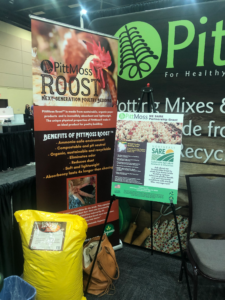
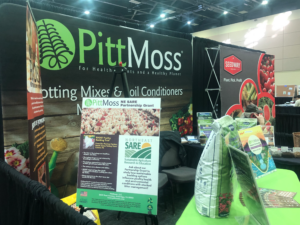
PittMoss had a booth at the 2022 Pasa Conference (February 9-12 2022) and created a display promoting the NE SARE partnership grant, our partner farmer and the project. The booth was manned by Mary Deemer and PittMoss staff and many quality conversations regarding our research project and sustainable bedding options for poultry with both producers and educators were had.
The project was submitted as a presentation topic for the 2023 conference but was not selected.
A summary of Educational and Outreach activities and materials at the end of the project.
Consultations 25
It is difficult to get an exact estimation of the number of discussions concerning the findings from the SARE research on using the PittMoss products in the stacked litter method. We have had direct conversations with a number of poultry farmers. On average I discuss poultry bedding at least once a week and reference the SARE work. The Sales staff for PittMoss LLC have attended a number of trade shows and presented some sales information referencing the SARE sponsored work at Davey Jones Farm. Grant Summary Paper July 2023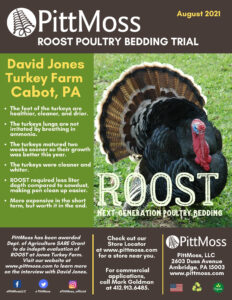
Curricula, Fact Sheets & Education Tools 6
- Various information and fact sheets have been produced as a result of the information developed from this research. Among the educational tools are those presented to company staff and sales representatives who pass along the findings associated with using the sustainable bedding in the staked or deep litter method. Some examples of the information are available in the links listed below. ROOST Update Sheet_3.28.23, Grant Summary Paper July 2023
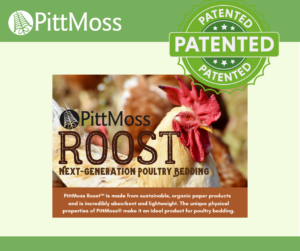
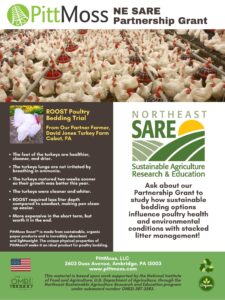
Journal Articles 0
On Farm Demonstrations and Testimonials 3
The advantages of the PittMoss Poultry Bedding have been acclaimed in testimonials by Mary Deemer.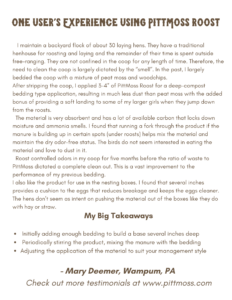 A testimonial by Lamppost Farm (link Testimonial) and praises of the Roost Bedding are noted in a recording that is available at PittMoss.com. and a proprietary report of trials at Mountain Side Farm is cicurated within PittMoss LLC.
A testimonial by Lamppost Farm (link Testimonial) and praises of the Roost Bedding are noted in a recording that is available at PittMoss.com. and a proprietary report of trials at Mountain Side Farm is cicurated within PittMoss LLC.
In addition, a demonstration on Joes Poultry Farm in Three Rivers, MI is under discussion.
Interviews with two producers were conducted by PittMoss staff concerning their results with the trials of the new sustainable bedding described as “Roost.” Both operations, Lamppest Farm interviewed on December 8th, 2023, and Reber Rock Farm, interviewed later, express high satisfaction and performance with the new more sustainable PittMoss bedding materials. Transcripts of the interviews will be made available at the PittMoss web site in the product information section.
Online Training 1
A posting in the PittMoss technical information section on animal bedding is being developed and should be available online by May of 2024. It will provide descriptions and effects of the stacked litter method with more environmentally beneficial litter management.
Published Papers and Articles 3
A news release was circulated online entitled “Something to Cluck about” on January 10th and a copy is available for viewing in the link below.
Two educational articles (magazine & online) are in process however, none are for journal review and publication. Both are articles for the APPPA Grist Magazine directed at pasture poultry producers. Their publication is expected in the first half of 2024. Further, PittMoss is mentioned in a recent article in Forestery.com online magazine issued January, 16, 2024. , ROOST Update Sheet_3.28.23
Additionally, a patent was granted and is published for recycled sustainable materials and can be reviewed in the attached link.
Tours 0
Webinars, Talks & Presentations 3
A brief overview of the research findings will be a part of the presentation on sustainable farm practices. It is scheduled for the OEFFA conference to be held in Newark Ohio on February 15th and 16th.
A Power Point presentation of the work done at Davey Jones Turkey Farm is available on link attached SARE Dave Jones Results Overview Version 1 and a more advanced and updated version will be posted on the PittMoss Website Technical Data Section following the filling of this report.
Additional PittMoss company-based presentations, webinars, and podcast are planned for presentations to poultry farmers and dealers.
Workshops & Field days 1
The findings from this research were presented at the West Michigan Sustainability Forum held in Grand Rapids Michigan on November 13, 2024. The findings will also be presented in brief at the ReCycle Michigan workshop in Lansing Michigan on January 30th.
As mentioned above, a demonstration on Joes Poultry Farm in Three Rivers, MI is under discussion.
Learning Outcomes
Only limited preliminary observations have been made to date. In preliminary applications and testing the farmer reported better leg health with much better foot health and fewer sores on the turkey's foot pads.
Project Outcomes
Much was learned in applying the new more sustainable bedding materials in the stacked liter management system. These examinations and evaluation of factors that influence bird health have application to everyone who raises poultry. In this project we thoroughly tested the physical and chemical impacts of three new sustainable recycled materials. They were manufactured from paper and cardboard waste. Our efforts were applied to evaluate whether the new bedding materials were superior to the most commonly used materials. The comparisons of three new innovative versions of bedding from PittMoss LLC to sawdust demonstrated an improved effectiveness of the trial materials. The new materials are shown to absorb ammonium better and maintain a better pH and air holding ability thus reducing the ammonia emissions. The properties presented in the experimental materials showed reductions in ammonia gas emissions into the ambient air over the bedding. Additional evaluations of the nitrogen content and conversions showed that the experimental bedding absorbed and sequestered the nitrogen more effectively in thus reduced the opportunity for leaching and runoff from the manure. Another good result is the reduction in moisture content and provide better absorption of the excreta. The data shows that the experimental materials work as good as or better than the sawdust control. As a further benefit the surface drying of the experimental materials was consistently better than that measure for the sawdust. The particle structure in the experimental bedding provided for lower surface moisture thus significantly contributing to better bird health.
The well-being of the birds was observed to be very good. Observations by the farmer indicated that the poults spent equal time over all the bedding materials and the accumulation rate of excreta appeared to be the same overall materials. It is clear that with the decreased moisture levels in the bedding and the improved chemistry many of the health problems associated with the poor-quality bedding will be greatly reduced when using the more sustainable formulations developed by PittMoss LLC. In this project triple benefits are observed. We have found ways to improve the bird health, reduce the probability of pollution from manure, and use material destined for the landfill for a beneficial purpose.
na
Information Products
- PittMoss NE SARE Partnership Grant Overview (Display)
- Key Finding Overview Presentation (Conference/Presentation Material)